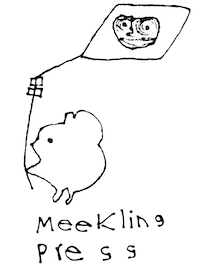We spoke briefly with art critic Gabriel Kendra about his critical practice as well as his obsession with artist Matthew Lacker’s Ten-Second Sculptures, four of which are featured alongside Kendra’s analyses in the latest Meekling Review. Lacker’s analysis of Kendra’s $33,224,369.98 was featured previously on the blog.

What first drew you to Gabriel Kendra’s work? And please, tell us more about his Ten Second-Sculptures in relation to his larger body of work.
His larger body of work–at least as far as I have seen–seems to focus on living a life that produces a constant stream of actions, objects, events, performances, structures, and thoughts that each individually could be construed as artworks. When I first encountered it I was fascinated by the way that art can be made so readily and so freely, it’s almost too good to be true. Whether it’s hitting a snooze button or swiping a metro-card I can sense that artful intent is present. I also feel that this artful intent is eager to be researched, developed, produced, market, financed, and distributed, which admittedly is the extent of my involvement with it.
I’m curious about your passion for non-glossy finishes. What else are you passionate about, Matthew Lacker?
When I was younger strangers would often confuse me with “Matte Lacquer” which is the matte version of a liquid made of shellac dissolved in alcohol, or of synthetic substances, that dries to form a hard protective coating for wood, metal, etc… As a child I was fascinated that another Matt Lacker existed, and I guess my fascination just grew from there.
Is art history/criticism your usual metier?
No, actually. I began as someone interested in the creation of art but found that it was not my forte. I lacked the panache, both technically and conceptually to compete in the mêlée that is the modern art world and ultimately felt that I was just a poseur with a Papier-mâché facade. Perhaps it is a faux pas to admit such personal failings, but now it is a fait accompli. I think I have evolved beyond the gaffe of my earlier career, and have become a creative entrepreneur of sorts, a generalist where each task is an hors d’œuvre which combine into an overall joie de vivre. I do not primarily dabble in art history or critique but it is one of my intellectual ac·cou·tre·ments. A knot in my macramé of pursuits I suppose.
Do you know if Kendra is constructing more 10-Second Sculptures in response to these politically fraught times? If so, can you disclose any hints as to what they might involve?
I am sure he is. As far as I am aware Kendra is in a near perpetual state of performing actions and identifying objects that have profound political and cultural resonance. He often does not speak candidly as to their meaning–I will have to take time out soon to examine them for significance.
Matthew Lacker is passionate about non-glossy finishes.
Gabriel Kendra is from Richmond, Virginia, and a graduate of VCUArts, currently living in Chicago and occasionally making zines.







